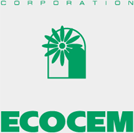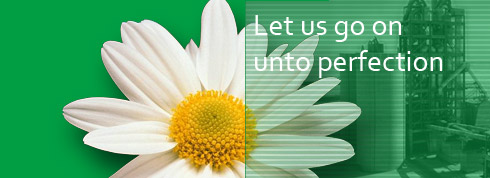

|
about us | news | articles | contact |
 |
 |
|
|
||
|
Developments from SCG "Ecologia"
JV "Belgorod cement" (Russia) In 2001 the technology was developed for feeding the mixture of by-products and fuel-containing materials into high-temperature zones of kilning unit 15. In 2001 the work on design of an installation for feeding electrical precipitator dust from the hot end was launched. JSV "Volyn" (Ukraine) In 1987-1988 a number of industrial tests were conducted on feeding blast-furnace granulated slag into kilning units. In 1995 the "Operational Schedule" was developed for design of an installation for feeding fusible compositions of by-products and fuel-containing materials into high-temperature zones of kilning units. 15.11.2001 a SCG "Ekologia" installation was put into operation for utilization of electrical precipitator dust for kilning unit #2; the installation provides dust feeding from the hot end of the kiln. JS "Lipetsk-cement" (Russia) SCG "Ekologia" experts have been working at the Lipetsk cement plant since 1974: In 1974 innovative methods of control were introduced for preparing raw mixtures with specified and homogeneous chemical composition on the first Soviet dry process line with high output (5x75m kiln). In 1974 the first batch of expanding cement with normal hardening periods was produced with slag of aluminothermic ferroalloy production used as an additive. Cement was used in construction of important reinforced concrete objects. During manufacturing pilot lots cement was converted from quality 300 to quality 400 without increasing Portland clinker content. In 1976-1978 industrial tests were conducted and technology was implemented for producing clinker from a raw mixture containing blast-furnace granulated slag. Heat consumption was reduced by 100 to 140 kcal/kg of clinker, clinker activity was increased by 5 MPa, the output of the 5x75m kiln was increased from 62 up to 75-80 tons per hour. The technology has been in use during 23 years. In 1989 a novel method of cement grinding control was tested under operational conditions; the method is based upon application of the index of predicted grade strength of the astringent. In 1989-1991 an industrial experiment on kilning clinker from raw mixture was carried out for the first time in the world cement iindustry; argillaceous component of the mixture was completely replaced with complex composition of by-products. In 1992 research was conducted on usability of various waste metallurgical products as active mineral cement admixtures. Extendability of the list of cement admixtures and achievability of a considerable energy-saving effect were proved. In 1993 foundry waste - used molding masses (UMM) - were utilized as active mineral cement admixture for the first time in cement industry. Including UMM in cement composition instead of similar amount of blast-furnace granulated slag made it possible to increase grade strength of slag Portland cement by 6.3 MPa. "Shchurovsk cement" (Russia) In 1994-1995 industrial tests were conducted on including foundry used molding masses in composition of raw mixture for white Portland cement clinker. "Oskolcement" (Russia) In 1971-1972 the commissioning of technology of raw material slurry with specified composition was carried out on the 1st and 2nd production lines. Principles of on-the-line adjustment of raw mixture composition and algorithm of rapid calculation of adjusting actions were developed. "Podolsk cement" (Ukraine) In 1973-1974 a new on-the-line technology of preparing raw material slurry with specified chemical composition was developed; the technology provided control of intermediate fine slurry flows at the input of slurry pumps. "Yenakiyevo cement plant" (Ukraine) In 1988 industrial tests were conducted on utilization of foundry used molding masses as active cement admixture. In 1989 used molding masses containing thermochemically activated silica were used for the first time as the siliceous component of the raw mixture for kilning white Portland cement clinker. The kiln productivity was increased by 12 - 16%, and heat consumption was reduced by more than 20%. In 1992 a novel technology of grinding mixed cements based upon rapid forecast of 28-day strength parameters of astringents was tested under production conditions for the first time in cement industry. A device for rapid forecast of cement activity was tested. In 1995 - 1996 compositions were developed for white Portland cement slag with increased content (up to 35%) of blast-furnace granulated slag; on the basis of these compositions "Specifications" were worked out, approved and put into operation. In 1997 the "Operational Schedule" was developed for design and construction of a modern production line for dry process. Results of research into creation of an "artificial argillaceous component" put into the OS made it possible to reduce 4-5 times estimate cost of production of the new production line. "Ivano-Frankovsk cement and slate plant" (Ukraine) In1995 research on the enterprise raw material base was conducted and the "Operational Schedule" was worked out to transfer one production line (kiln 13) to the dry process. In 1998 additional researches were made and included in the feasibility study to transfer the plant to the dry process based on the equipment of "F.L.Smidth" "Krivoy Rog cement and mining plant" (Ukraine) In 1982-1983 commissioning was conducted for a technology of preparing raw mixture of specified composition on the 3rd line (dry process kiln with the first Soviet reactor-decarbonizer (Onoda-Cement -Japan). In 1984 industrial tests were conducted on including used molding masses in cement composition. Saving up to 7% of clinker or increasing the cement ultimate strength by 6.8 MPa with pressing at 28-day age with replacement of 5% of blast-furnace slag by UMM were proved possible Rezinsk cement plant (Moldova) In 1985-1986 a technology for preparation of raw meal with specified chemical composition on the plant 1st line with the output of 3000 tons of clinker per day was started up, commissioned and implemented. In 1986-1988 a complex of works was realized to organize for the first time in the USSR production of Portland cement of quality 500 at the dry process plant. Within the framework of that project: In 1989-1990 the "Operational Schedule" for design and construction of the 2nd production line with capacity of 5000 tons of clinker per day was developed. "Doncement" (Ukraine) In 1994-1996 a complex of work was realized to intensify the cement grinding process, including: In 1996-1997 a series of industrial tests was conducted and the method of kilning intensification by feeding solid fuel and blast-furnace slag into the decarbonization zone of the 4x150m kiln was commercially implemented. Heat consumption for kilning was reduced by 13%, the kiln capacity was increased by 10%, the clinker activity at early stages of hydration was increased. In 1998 a comprehensive program for reducing power consumption of "Doncement" production facilities was developed. Within implementation of the program. In 1998 the technology of preparation of raw slurry with specified chemical composition was improved. In 1998 researches were conducted on feasibility of replacement of chalk by limestone of Karakub field. In 1998 the "Operational Schedule" was developed for production of lime for metallurgical needs in the 5x185m kiln. In 1998 the "Operational Schedule" was developed for feeding fusible by-product compositions into kilns 113-6. In 1998 the "Operational Schedule" was developed for reconstruction of kiln #7 and its transfer to the dry process. Two variants of technology of raw meal preparation were developed to satisfy needs of raw materials for the dry process line. "Kramatorsk cement and slate plant - Pushka" (Ukraine) In 1997-1998 a new on-the-line technology of preparation of raw slurry with specified chemical composition and process control based on vertical slurry tanks was developed and tested under production conditions. In 1998 recommendation were put forward for adjustment of modular characteristics of raw mixture and clinker chemical and mineral composition. Implementation of these recommendations made it possible to reduce heat consumption during clinker kilning and power consumption during cement grinding. In 1999 searching was conducted for new raw material base of cement industry, and proposals were developed to transfer the plant to the dry process "Balcem" (Ukraine) In 1977-80 the balancing of all the milling stock (cement mills) of the plant was conducted. In 1995 a technology and control scheme for using ash in raw slurry were developed; industrial tests were conducted. In 1998 a comprehensive program for reducing power consumption and improving quality of products was developed. In 2001 preliminary proposals were developed for destruction of unserviceable pesticides in a clinker kilning unit. "Nikolayevcement" (Ukraine) In 1974-1976 rod and ball mills for raw materials were set up. In 1992 proposals were developed for improvement of technology of raw slurry preparation. An algorithm was designed for rapid calculation of adjusting actions during on-the-line adjustment process based on the saturation factor and modular characteristics. "Kyzylkumcement" (Uzbekistan) In 1976-1978 the 1st and 2nd dry process production lines were commissioned and technology of preparation of raw mixture with specified composition was adjusted. In 1997 a new scheme of control of raw meal simultaneous preparation for two production lines with one metering block was developed based on the principle of temporary division of raw material flows and implemented. "Kavkazcement" (Russia) In 1977-1978 new types of cement grinding intensifiers were put into operation. In 1996 proposals were developed for improving the process of preparation of raw slurry with specified chemical composition and a scheme of on-the-line control was designed. In 2000 a device for infeed of dust trapped by electrical precipitator from the hot end of rotary kilns was designed and tested under production conditions "Dneprocement" (Ukraine) In 1980-1982 researches and industrial tests were conducted on utilization of natural materials - basalts - as part of raw materials being burnt. In 1985-1986 researches were conducted on serviceability of converter process slag in cement industry. "Rustavicement" (Georgia) In 1979-1981 comprehensive researches (including industrial tests) was conducted into utilization of un-ground dump highly ferrous metallurgical slag as a raw slurry component. In1999-2000 a unique raw material base and technology of cement production were developed for a projected mini-plant at the request of "E.B.A.C" company. Devnya, Temelkovo (Bulgaria), Varta, Stshelske-Opolske (Poland). Commissioning of the process of preparation of raw slurry with specified composition designed by the "Yzhgiprocement" Institute (Kharkov). Teploozersk cement plant (Russia) The "Operational Schedule" for design of a new production line for dry process was developed. Sterlitamak plant "Soda" - cement production facility (Russia) In 1985 comprehensive proposals were elaborated for upgrading cement production and implementation of advanced technical solutions at all technological stages. "Odessacement" (Ukraine) In 1993 pilot batches of cement containing used molding masses as an active mineral admixture were produced. Saving of up to 9% of Portland clinker without decrease of cement strength characteristics with simultaneous reduction of power consumption during grinding was proved feasible. "Kievcement" (Ukraine) In 1991-1992 a technology and control scheme was developed for the grinding process when dump blast- and electric furnace slag (which had been processed beforehand to isolate metallic impurities) was used as active mineral admixture. "Akhagarancement" (Uzbekistan) In 1993 the "Operational Schedule" for design and construction of a new production line for dry process was developed. "Tajikcement" (Tajikistan) In 1993 the "Operational Schedule" for design and construction of a new production line for dry process was developed. |
||
| 2006 © www.ecocem.com |